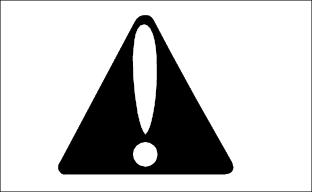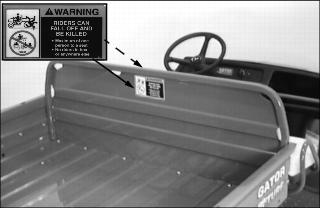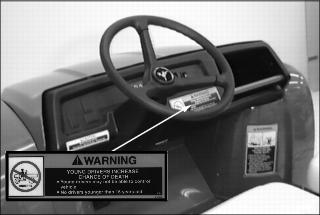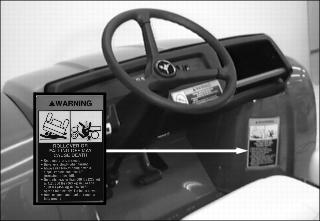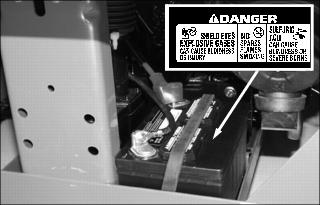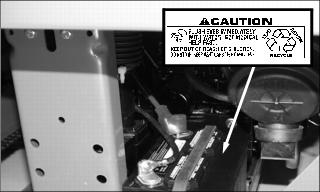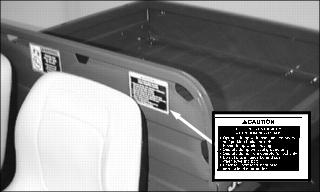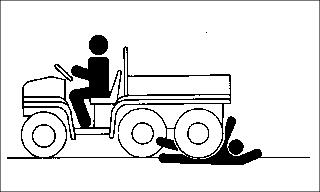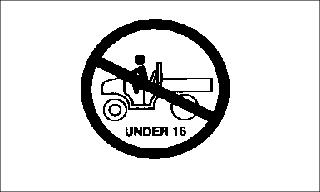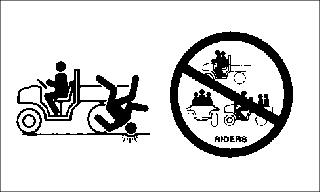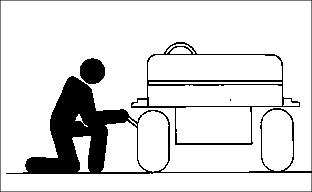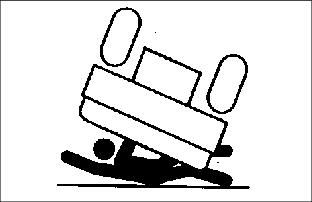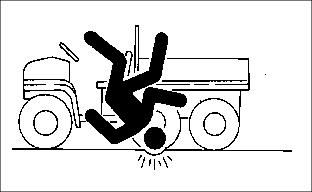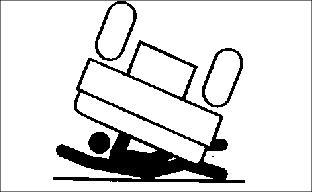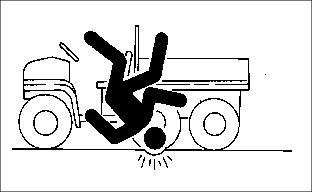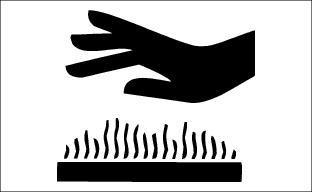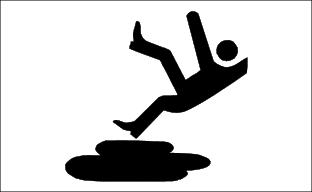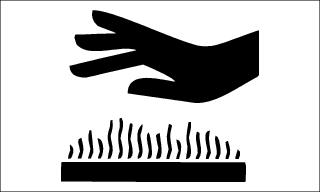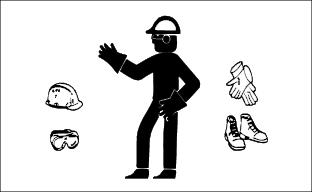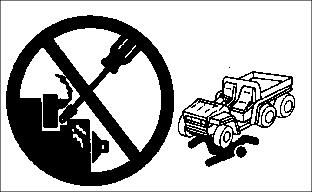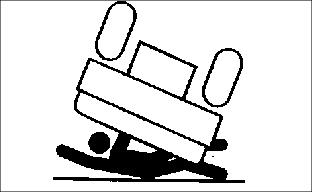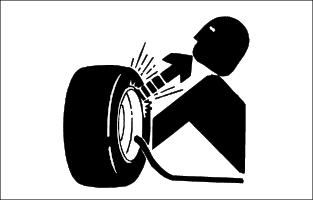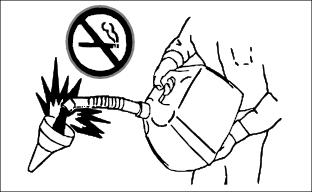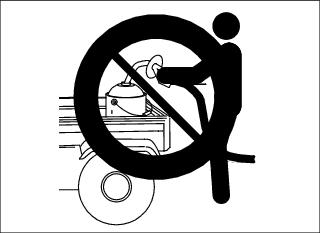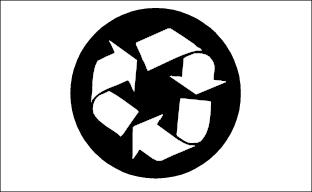Introduction
Product Identification
Safety
Understanding The Machine Safety Labels
WARNING: RIDERS CAN FALL OFF AND BE KILLED
WARNING: YOUNG DRIVERS INCREASE CHANCE OF DEATH
WARNING: ROLLOVER OR FALLING OFF MAY CAUSE DEATH
CAUTION: HELP PREVENT INJURY WHEN DUMPING LOADS
Emission Control System Certification Label
Protect Children and Prevent Accidents
Handling Waste Product and Chemicals
Operating
Replacement Parts
Service Intervals
Service Lubrication
Service Engine
Service Transmission
Service Electrical
Service Miscellaneous
Troubleshooting
Storage
Assembly
Specifications
Warranty
John Deere Quality Statement
Service Record
Copyright© Deere & Company

Safety
Understanding The Machine Safety Labels
The machine safety labels shown in this section are placed in important areas on your machine to draw attention to potential safety hazards.
On your machine safety labels, the words DANGER, WARNING, and CAUTION are used with this safety-alert symbol,. DANGER identifies the most serious hazards.
The operator's manual also explains any potential safety hazards whenever necessary in special safety messages that are identified with the word, CAUTION, and the safety-alert symbol,.
WARNING: RIDERS CAN FALL OFF AND BE KILLED
· Maximum of one person to a seat.
· No riders in box or anywhere else.
WARNING: YOUNG DRIVERS INCREASE CHANCE OF DEATH
· Young drivers may not be able to control vehicle.
· No drivers younger than 16 years old.
WARNING: ROLLOVER OR FALLING OFF MAY CAUSE DEATH
· Drive very slowly when turning.
· Always use brakes going down a slope. Vehicle can take-off (freewheel) downhill.
· No loads heavier than 500 lbs (227 kg) in 4x2, 800 lbs (363 kg) in 6x4 and 1000 lbs (454 kg) in 6x4 DIESEL. Spread load evenly. Tie loads down.
· Reduce speed and load on rough or hilly ground.
CAUTION
DANGER
SHIELD EYES
EXPLOSIVE GASES can cause blindness or injury.
NO
SULFURIC ACID
Can cause blindness or severe burns.
CAUTION
Flush eyes immediately with water. Get medical help fast.
Keep out of reach of children.
Keep vent caps tight and level.
CAUTION: HELP PREVENT INJURY WHEN DUMPING LOADS
NOTE: For machines with cargo box power lift option only.
· Operate dump with machine stationary and parking brake locked: Never dump while moving.
· Operate dump on level ground only.
· Operate dump from operator's seat only.
· Do not place hands behind seat when lowering box.
· Refer to Operator's Manual for correct load distribution.
Emission Control System Certification Label
NOTE: Tampering with emission controls and components by unauthorized personnel may result in severe fines or penalties. Emission controls and components can only be adjusted by EPA and/or CARB authorized service centers. Contact your John Deere Commercial and Consumer Equipment Retailer concerning emission controls and component questions.
The presence of an emissions label signifies that the engine has been certified with the United States Environmental Protection Agency (EPA) and/or California Air Resources Board (CARB).
The emissions warranty applies only to those engines marketed by John Deere that have been certified by the EPA and/or CARB; and used in the United States and Canada in off-road mobile equipment.
Emission Compliance Period
If your engine has the emission compliance category listed on the emission control system certification or air index label, this indicates the number of operating hours for which the engine has been certified to meet EPA and/or CARB emission requirements. The following table provides the engine compliance period in hours associated with the category found on the certification label.
Operating Safely
· View the videotape provided with the vehicle for safe operating practices.
· Do not misuse the utility vehicle. It is a utility vehicle, not a recreation vehicle.
· The utility vehicle is not intended for use on highways or public roads. Do not operate vehicle on a road where the vehicle may be a hazard to faster-moving traffic.
· Horseplay or recreational riding can lead to accidents, severe bodily injury or death.
· Sit on the center of the seat and keep both feet within the foot platform perimeter. Clean foot platform if dirty, and remove any debris from around foot controls.
· Check for debris in engine compartment, especially around brake linkage on each side of the transaxle.
· Always use both hands for steering.
· Know location of controls and how and what they operate.
· Never operate utility vehicle while standing.
· Never operate utility vehicle with the cargo box raised.
· Check brake action before beginning vehicle operation. Adjust or service the brakes as necessary.
· To provide adequate braking ability and traction, do not tow any attachment or loaded trailer unless the utility vehicle cargo box is fully loaded.
· Inspect vehicle before operating. Be sure hardware is tight. Repair or replace damaged, badly worn, or missing parts. Be sure guards and shields are in good condition and fastened in place. Make any necessary adjustments before operating.
· Keep people and pets out of the work area. Stop the vehicle if anyone enters the area. If an object is hit, stop and inspect the vehicle for damage. Make repairs before operating.
· Do not leave vehicle unattended when it is running.
· Only operate during daylight or with good artificial light.
· Be careful of traffic when operating near or crossing roadways.
· This vehicle is not intended for use on highways or public roadways. It is to be used for off-road use only.
· Avoid sudden starts, stops, or turns.
· Always use a level turn-around area.
· Do not wear headphones while operating.
Protect Children and Prevent Accidents
· Never assume that children will remain where you last saw them. Stay alert to the presence of children.
· Never carry children in the cargo box area. DO NOT let children ride in the cargo box of the utility vehicle or any attachment. DO NOT tow children in a cart or trailer.
· Use extra care when coming to blind corners, shrubs, trees, or other objects that may block vision.
· DO NOT let children or an untrained person operate the vehicle.
· Before backing or turning, look behind and around the utility vehicle for children.
· Be alert at all times, drive forward and in reverse carefully. People, especially children, can move quickly into an area of operation.
· Back carefully. Look behind the vehicle, especially for children, before backing up.
· DO NOT operate vehicle if under the influence of alcohol or other drugs.
· Misuse and recreational riding can lead to accidents, severe bodily injury or death.
Operator Training Required
Study operation and safety sections of this manual before operating the vehicle.
· Operate vehicle in an open, unobstructed area under the direction of an experienced operator.
· Learn the use of all controls.
· Operator experience is required to learn the moving, stopping, turning and other operating characteristics of the vehicle.
· Young drivers may not have the strength or experience to control the utility vehicle. This increases the chances of rolling the vehicle over resulting in severe bodily injury or death.
· The utility vehicle should NOT be operated by anyone under the age of 16 years.
Keep Riders Off Vehicle
· Seating is provided for operator and one passenger. No riders are allowed in cargo box or anywhere else on vehicle.
· Riders on vehicle are subject to injury such as being struck by foreign objects or being thrown off of the vehicle and severely injured or killed.
· Riders affect the operator's ability to control the vehicle as well as its center of gravity. Also, riders could obstruct the operator's view resulting in the vehicle being operated in an unsafe manner.
· Never allow riders in the cargo box or other areas where seats are not provided.
Before Driving
1. Clean foot platform if dirty, and remove any debris from around foot controls. Sit on the center of seat and keep both feet inside foot platform perimeter.
2. Know location of controls and how and what they operate.
3. Inspect utility vehicle for signs of wear or damage.
4. All safety equipment must be in good condition and fastened in place:
5. Before moving, check around utility vehicle, be sure no one is near it.
6. Inspect mechanical condition of your vehicle before each use to minimize chance of injury or being stranded. Remember, you can ride farther in an hour then you can walk in a day.
Be sure to check condition of tires and wheels, wheel hardware torque, and maintain proper tire pressure.
Parking Safely
1. Stop the vehicle on a level surface, not on a slope.
5. Before you leave the operator's seat, wait for engine and all moving parts to STOP.
Transport Loads Safely
Be sure load guard is properly installed.
Be sure load is evenly distributed.
Securely anchor all loads in cargo box.
Reduce cargo box capacity when operating on rough or hilly terrain.
Avoid Tipping
Accidents resulting in serious injury or death can occur from tipping the utility vehicle. Observe the following practices to help prevent accidents:
· DO NOT misuse the utility vehicle. The utility vehicle is not designed for recreational riding.
· Drive very slowly when turning. Sharp turns could cause the utility vehicle to tip over.
· Reduce speed and exercise extreme caution on slopes or on rough ground.
· DO NOT overload vehicle and avoid shifting loads. Reduce load when operating over rough or hilly terrain.
· DO NOT stop or start suddenly when going uphill or downhill. Be especially cautious when changing direction on slopes.
· Stay alert for holes, rocks, and other hidden hazards in the terrain.
· Keep front wheels straight at crest of hill or going over bumps.
· When descending a hill, remove foot from accelerator and apply brakes to reduce speed and maintain control.
· DO NOT make changes or modifications to the utility vehicle.
· Use of a helmet and/or protective gear is recommended for certain operating conditions.
Driving On Rough Terrain
· Use existing trails. Avoid terrain such as dangerous slopes and impassable swamps. Watch carefully for sharp bumps, holes, ruts, or obstacles.
· Look ahead at terrain. Know what is coming and be prepared to react. Be alert for hazards.
· Keep front wheels straight at crest of hill or going over bumps.
· Reduce speed according to trail, terrain, and visibility conditions.
· Use of a helmet and or protective gear is recommended for certain operating conditions.
Climbing Or Descending A Hill
· Always use the brakes when going down slopes, the utility vehicle can speed up (freewheel) going down a slope. Due to belt drive, engine and/or clutch braking effect is minimal.
· Balance loads evenly and secure them. Braking could shift the load and affect vehicle stability.
· Sit on center of seat and keep both feet within foot platform.
· Never drive past the limit of visibility. Slow down near crest of hill until getting a clear view of the other side.
· Keep front wheels straight at crest of hill or going over bumps.
· Do not stop or start suddenly when going uphill or downhill. Be especially cautious when changing direction on slopes.
· If vehicle stops or loses power going up a hill, lock park brake to hold vehicle on slope. Maintain direction of travel and release brake slowly. Back straight down hill slowly while maintaining control. Do not turn vehicle sideways. Vehicle is more stable in a straight forward or rearward position.
· When descending a hill, remove foot from accelerator and apply brakes to reduce speed and maintain control.
· Use of a helmet and/or protective gear is recommended for certain operating conditions.
Driving Across Slopes
· Reduce speed and use caution on slopes and in sharp turns.
· Sit on center of seat and keep both feet within foot platform perimeter.
· Stay alert for holes, rocks and other hidden hazards in the terrain.
· When riding on soft terrain, turn front wheels slightly uphill to keep utility vehicle on a straight line across the hill.
· If utility vehicle begins to tip, turn front wheel downhill to gain control before proceeding.
· Use of a helmet or protective gear is recommended for certain operating conditions.
Riding Through Water
· Avoid water whenever possible. If drive belt becomes wet, slippage will occur and vehicle will lose power.
· Never cross any body of water where depth may be unknown to the operator. As an operational guideline, deep water is considered anything in excess of 152 mm (6 in.) in depth. Tires may float, making it difficult to maintain control.
· Sit on center of seat and keep both feet within foot platform perimeter.
· Choose a course within the waterway where both banks have a gradual incline. Cross at a point known to be safe.
· Proceed at a slow steady speed to avoid submerged obstacles and slippery rocks.
· Avoid water crossings where the operation of a utility vehicle may cause damage to waterway beds or erode waterway shoreline.
Prevent Fires
· Never remove fuel cap, or add fuel with engine running or hot. Allow engine to cool for several minutes.
· Never store equipment with fuel in the tank inside a building where fumes may reach an open flame or spark.
· Allow engine to cool before storing in any enclosure.
· To reduce fire hazard, keep engine free of grass, leaves, or excessive grease.
Practice Safe Maintenance
· Understand service procedure before doing work. Keep area clean and dry.
· Never lubricate, service, or adjust machine while it is moving. Keep safety devices in place and in working condition. Keep hardware tight.
· Keep hands, feet, clothing, jewelry, and long hair away from any moving parts, to prevent them from getting caught.
· Lower attachments to the ground before servicing machine. Disengage all power and stop the engine. Lock park brake and remove the key. Let machine cool.
· Securely support any machine elements that must be raised for service work.
· Never run engine unless park brake is locked.
· Keep all parts in good condition and properly installed. Fix damage immediately. Replace worn or broken parts. Remove any buildup of grease, oil, or debris.
· Disconnect battery negative (-) cable before making adjustments on electrical systems or welding on machine.
· Do not modify machine. Unauthorized modifications may impair its function and safety.
· Do not wear radio or music headphones while servicing the machine. Safe service requires your full attention.
Wear Appropriate Clothing
· Wear close fitting clothing and safety equipment appropriate for the job.
· Wear a suitable protective device such as earplugs. Loud noise can cause impairment or loss of hearing.
· Do not wear radio or music headphones. Safe service and operation requires your full attention.
Prevent Vehicle Runaway
Avoid possible injury or death from vehicle runaway:
· Do not start engine by shorting across starter terminals. Machine will start in gear if normal circuitry is by-passed.
· NEVER start engine while standing on ground. Start engine only from operator's seat with park brake locked.
Do Not Modify Machine
Do not make any unauthorized modifications to the machine in anyway.
Modifications can result in making the machine unstable, increasing the possibility of rollover causing severe bodily injury or death.
Tire Safety
Explosive separation of a tire and rim parts can cause serious injury or death:
· Do not attempt to mount a tire without the proper equipment and experience to perform the job.
· Always maintain the correct tire pressure. Do not inflate the tires above the recommended pressure. Never weld or heat a wheel and tire assembly. The heat can cause an increase in air pressure resulting in a tire explosion. Welding can structurally weaken or deform the wheel.
· When inflating tires, use a clip-on chuck and extension hose long enough to allow you to stand to one side and NOT in front of or over the tire assembly.
· Check tires for low pressure, cuts, bubbles, damaged rims or missing lug bolts and nuts.
Checking Wheel Bolts
· A serious accident could occur causing serious injury if wheel bolts are not tight.
· Check wheel bolt tightness often during the first 100 hours of operation.
Handling Fuel Safely
Fuel and fuel vapors are highly flammable:
· DO NOT refuel machine while you smoke, when machine is near an open flame or sparks, or when engine is running. STOP engine.
· Prevent fires: clean oil, grease and dirt from machine. Clean up spilled fuel immediately.
· Do not store machine with fuel in tank in a building where fumes may reach an open flame or spark.
· Prevent fire and explosion caused by static electric discharge. Use only non-metal, portable fuel containers approved by the Underwriter's Laboratory (U.L.) or the American Society for Testing & Materials (ASTM). If using a funnel, make sure it is plastic and has no screen or filter.
· Static electric discharge can ignite gasoline vapors in an ungrounded fuel container. Remove the fuel container from the bed of a vehicle or the trunk of a car and place on the ground away from the vehicle before filling. Keep nozzle in contact with container opening while filling.
· When practical, remove equipment from trailers or truck beds and refuel them on the ground. If this is not possible, use a portable, plastic fuel container to refuel equipment on a truck bed or trailer.
· DO NOT use METHANOL gasoline. METHANOL is harmful to the environment and to your health.
Handling Waste Product and Chemicals
Waste products, such as, used oil, fuel, coolant, brake fluid, and batteries, can harm the environment and people:
· DO NOT use beverage containers for waste fluids - someone may drink from them.
· See your local Recycling Center or John Deere dealer to learn how to recycle or get rid of waste products.
· A Material Safety Data Sheet (MSDS) provides specific details on chemical products: physical and health hazards, safety procedures, and emergency response techniques. The seller of the chemical products used with your machine is responsible for providing the MSDS for that product.

